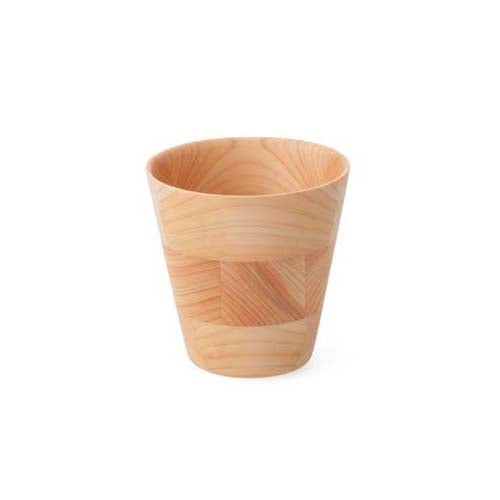Let us explain how to care wooden tableware.
The products we used:
Main Types of Wooden Tableware
Here are the main types of wooden tableware and the features of each.
Made with Oil Finish

Oil finish is a method of finishing wood by allowing oil to soak into the wood. The oil penetrates into the wood, preventing it from drying out, deforming and cracking, and protecting the material from stains and other contaminants.
Another feature is the texture of the wood grain.
However, since it does not protect the surface as strongly as lacquer or urethane coatings, its resistance to stains and scratches is somewhat lower than that of lacquer and urethane coatings.
Lacquer and Urethane Coating

Lacquer and urethane coating is a method of finishing wood surfaces by coating them with resin. The strong protective function of the resin protects the surface of the tableware from stains and scratches. It is also more impact-resistant than oil finish.
It is also an effective finishing method when you want the surface to be glossy.
Stain

Stain is a type of paint that is smeared on wood. There are oil-based and water-based stains; oil-based is called "oil stain" and water-based is called "water-based stain.
It does not have the protective function of an oil finish, but it is characterized by its ability to highlight the grain of the wood more beautifully.
Lacquering

Lacquer is a finishing technique that uses a paint made from the sap extracted from the Anacardiaceae plant. It is resistant to acidity and alkalinity, and has excellent heat resistance, durability, antibacterial, antiseptic, and mothproof properties. However, the most distinctive feature is the beautiful luster. Many ancient Japanese crafts also utilize the luster of lacquer.
Wax Finish

This method uses a glazing material made from beeswax. This technique is often seen in Western antiques, etc., and is featured by its light luster that gives it a unique, luxurious appearance.
How to Wash and Store Wooden Dishes
Let us explain how to wash and store wooden dishes.
How to Wash Wooden Dishes

If wooden tableware is left soiled, the stain may soak into the wood and cause stains or mold. Wash immediately after use.
Use a soft sponge and mild detergent for cleaning. Do not use steel wool, metallic brushes, etc. as they may cause scratches. If there are no greasy stains or other persistent stains, just a quick wash under running water is fine. Excessive use of detergents may remove even the wood's natural oils, so care should be taken.
After cleaning, thoroughly wipe off the water and dry in a well-ventilated place.
How to Store Wooden Tableware

If it is stored for a long time, dry it thoroughly so that no moisture remains on it. Storing with moisture or stains remaining can cause mold growth.
It is also effective to wrap them in newspaper to prevent mold and mildew when storing them. Newspaper acts as a moisture absorbent and helps prevent mold.
What Not to Do with Wooden Tableware
Let us describe precautions for handling wooden tableware.
Soak in Water for a Long Time

When wooden tableware is soaked in water for long time, the wood absorbs the water and swells. By doing so, the shape may be distorted or cracked. It is also more difficult to dry, which can cause mold.
Wooden dishes should not be soaked in water and should be washed and dried immediately after use.
Expose to Sunlight Directly

Avoid exposure to direct sunlight, as this may cause deformation and cracking.
Dry them in an airy, shady place.
Use Dishwasher and Microwave

Wooden tableware is susceptible to sudden changes in temperature, so please do not use a dishwasher or microwave oven for items not marked "microwavable" or "dishwasher safe". It may cause deformation and cracking.
Put in Refrigerator

Putting wooden tableware in a cold, dry refrigerator may cause deformation or cracking due to rapid drying and temperature changes. Wooden tableware should not be kept in the refrigerator for long time, as it easily picks up food odors. Move food from wooden dishes to storage containers when refrigerating food, as this can cause stains.
Maintenance of Wooden Tableware
Let us describe how to maintain wooden tableware.
Remove Scratches and Stains on the Surface

Stains on the surface of wooden dishes should be scrubbed off with a soft sponge. If it is difficult to remove, use a neutral detergent.
If you want to remove fine scratches, use fine-grit sandpaper or an abrasive sponge to gently rub along the grain of the wood to make them less conspicuous.
Coated with Cooking Oil

Wooden tableware tends to dry out over time. Maintain them with oil once every two to three months. Dry oils such as flaxseed oil, walnut oil, and egoma oil, which become dry and silky when dried, are recommended. However, olive oil or lemon oil are alternative.
How to Serve Food to Prevent Stains Caused by Food
Dark-colored dishes such as curry and stew can cause stains on wooden tableware. Also, avoid using wooden tableware as much as possible, as the odor may be difficult to remove.
If you must use wooden tableware for curry etc., it is necessary to spread a cookie sheet or wax paper, or coat the tableware with oil in advance to prevent color and odor from being transferred.
Long-Lasting Wooden Tableware
Unlike glass or ceramics, wooden tableware is not easily broken, and you can enjoy the depth of color and change in texture over time. If used well, it can be used for a lifetime.
With proper use and care, you can enjoy your precious wooden tableware for many years to come.






